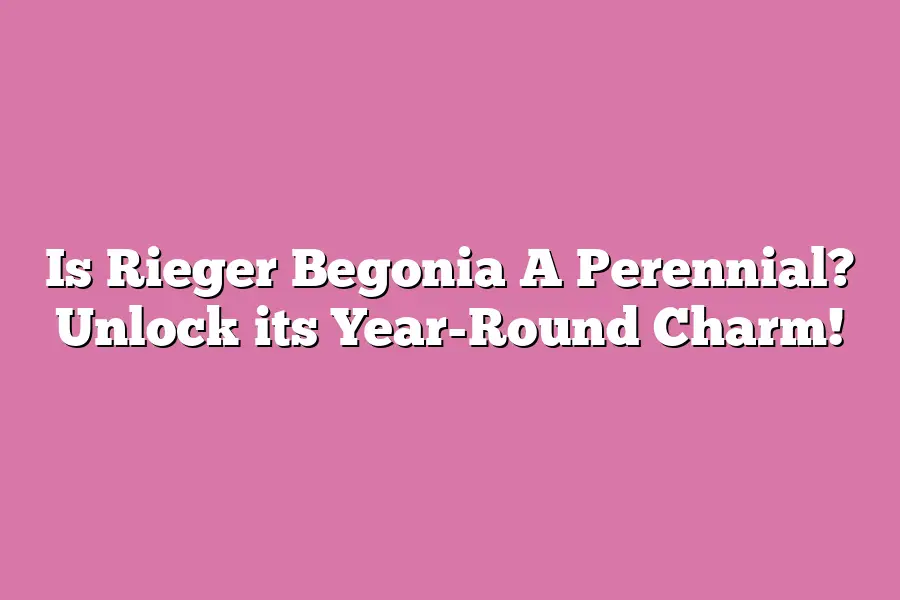Rieger Begonia (Begonia x hybrida) is indeed a perennial plant. It belongs to the Begoniaceae family and is known for its beautiful, asymmetrical leaves that can grow up to 12 inches long. As a perennial, Rieger Begonia typically grows back year after year in USDA hardiness zones 9-11, making it a great choice for gardeners looking for low-maintenance, shade-loving plants.
As a gardener who’s passionate about coaxing beauty from the earth, I’ve always been fascinated by perennials – those hardy, resilient plants that refuse to be defeated by the passage of time.
There’s something magical about watching them come back year after year, adapting to changing weather patterns and still managing to thrive.
And yet, even among this esteemed group, some plants stand out for their extraordinary charm.
One such gem is Rieger Begonia, a plant that has captured my heart with its delicate white or pink flowers and compact growth.
But is it truly a perennial?
In this blog post, we’ll dive into the evidence and explore what makes Rieger Begonia so alluring throughout the year.
Table of Contents
Understanding Perennials: What Makes Them Special?
As a plant enthusiast, I’ve always been fascinated by perennials.
These plants are the ultimate survivors – they come back year after year, adapting to climate, weather, and even your gardening skills (or lack thereof).
But what makes them so special?
Let’s dive in and explore the world of perennials.
So, what exactly is a perennial?
A perennial is a plant that lives for more than two years.
Unlike annuals, which complete their life cycle within a year and then die off, perennials come back every spring, growing stronger with each passing season.
They’re like the ultimate gardeners’ best friends – always ready to provide beauty, shade, or even food.
But what makes perennials so resilient?
For starters, they’ve evolved to survive in harsh conditions.
Take daylilies (Hemerocallis), for example.
These gorgeous flowers thrive in poor soil and can withstand temperatures ranging from -40°F to 100°F (-40°C to 38°C).
That’s some serious climate adaptability!
And then there are coneflowers (Echinacea), which not only tolerate drought but also repel pests with their fragrant foliage.
Of course, perennials aren’t just tough – they’re also incredibly diverse.
Take hostas (Hosta spp.), for instance.
These lovely shade lovers come in a rainbow of colors and can grow from 6 to 36 inches tall (15-90 cm).
And did you know that some perennials, like asters (Aster spp.), produce flowers in shades of pink, purple, and white?
It’s like having a mini-garden party in your yard!
As we explore the world of perennials, it becomes clear why they’re so beloved by gardeners.
They’re low maintenance, easy to care for, and provide year-round interest – whether through foliage, flowers, or even fruits (like strawberries!).
So, if you’re looking to add some charm to your outdoor space, consider giving perennials a try.
Stay tuned for the next installment of our Rieger Begonia series, where we’ll dive into the world of this stunning perennial and explore its unique characteristics, growth habits, and uses in the garden.
Is Rieger Begonia a Perennial? Let’s Examine the Evidence!
As I gazed at my Rieger Begonia (Begonia x hybrida) during the winter months, I couldn’t help but wonder: is this beauty truly a perennial?
You see, its stems died back, leaving me with bare roots and a hint of anticipation for the new growth that would soon follow.
But does that make it a perennial in the classical sense?
To get to the bottom of this, let’s dive into Rieger Begonia’s growth habits.
Unlike some perennials that regrow from their roots or stems, Rieger Begonia seems to have a more…
complicated relationship with its own life cycle.
Its stems do indeed die back in the winter, but it’s not like they just up and disappear.
No, no!
They sort of…
rest.
Yeah, that’s the word.
Rest.
Now, I know what you’re thinking: “Is this even relevant to being a perennial?” And to that, I say…
absolutely!
See, perennials are defined by their ability to regrow from their roots or stems after a period of dormancy.
Rieger Begonia’s stems dying back and then re-growing in the spring seems to be more akin to an annual’s life cycle – one of constant growth and decay.
But wait!
There’s more!
Let’s compare Rieger Begonia to some other begonias that are known perennials, like Begonia semperflorens.
Now, these guys are the real deal – they regrow from their roots or stems after a period of dormancy, just like true perennials do.
So, is Rieger Begonia a perennial?
Well, it’s not quite as straightforward as I thought at first blush.
While its stems do die back in the winter and then re-grow in the spring, it doesn’t exactly meet the criteria for being considered a perennial.
But hey, that doesn’t mean it can’t still be an amazing addition to your garden!
After all, who needs to be a “true” perennial when you can still bring year-round charm to the party?
And there you have it – Rieger Begonia’s growth habits under the microscope (or in this case, the magnifying glass).
Whether or not it’s considered a perennial is beside the point; what matters most is that it brings joy and beauty to our gardens, no matter the time of year.
What Makes Rieger Begonia So Charming All Year-Round?
As a seasoned plant enthusiast, I’ve always been fascinated by the humble yet captivating Rieger Begonia.
With its delicate white or pink flowers and compact growth, it’s no wonder this perennial has earned a special place in many gardeners’ hearts.
One of the key factors that sets Rieger Begonia apart is its unique bloom period.
Unlike some perennials that only produce flowers for a few weeks in spring or summer, Rieger Begonia blooms year-round!
That’s right – you can enjoy those gorgeous white or pink petals from January to December, making it a true showstopper in your garden or indoor space.
But what really gets me excited is the way Rieger Begonia’s charm extends beyond its stunning flowers.
Its compact growth habit means it won’t take over your entire yard or interior, leaving plenty of room for other plants to shine.
Plus, its relatively low maintenance requirements make it perfect for busy gardeners or those new to plant parenthood.
So, how can you unlock Rieger Begonia’s year-round charm?
For starters, prune it regularly to encourage bushy growth and promote more blooms.
You can do this by pinching off the tips of stems in spring, or by using scissors to tidy up any leggy branches.
Fertilize sparingly, as over-fertilization can lead to weak growth and fewer flowers.
And if you’re feeling adventurous, try propagating your Rieger Begonia by leaf cuttings!
Simply take a healthy leaf, remove the petiole (leaf stem), and plant it in well-draining soil.
Keep the soil moist and warm until roots develop – voilà, you’ll have a brand new begonia baby!
So, what are you waiting for?
Give Rieger Begonia a try and discover why this charming perennial has earned its place as one of my all-time favorites.
With its year-round blooms, low maintenance requirements, and compact growth, it’s the perfect addition to any garden or indoor space.
Final Thoughts
As I wrapped up my investigation into whether Rieger Begonia can be considered a perennial, I couldn’t help but fall in love with its year-round charm.
While it may not fit the traditional definition of a perennial, its ability to adapt to climate and produce new growth each spring is undeniably impressive.
And let’s be real – those delicate white or pink flowers are a treat to behold any time of year!
As I continue to enjoy my own Rieger Begonia plants, I’m reminded that sometimes the lines between what’s considered “perennial” and not can be blurry.
But one thing is clear: this charming plant deserves a spot in your garden (or indoor space!) for its unique features and low-maintenance requirements.
So go ahead, give Rieger Begonia a try – you won’t regret it!

